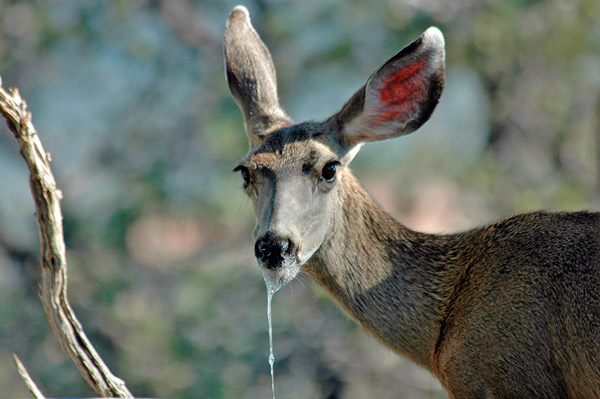Outdoor Pursuits

with Rob Miskosky
From the Editor - July 2024

A mule deer in the late stages of chronic wasting disease foaming at the mouth.
A lingering question in regards to chronic wasting disease (CWD) has been whether or not it is transmissible from cervids—deer, moose and elk—to people. It is a question that has been asked for decades—can people who eat meat from CWD-infected cervids develop chronic wasting disease?
CWD primarily involves deterioration of the brain, and while CWD has not been documented to infect humans, concerns persist about its potential to cross the species barrier.
Studies have demonstrated that certain non-human primates, such as macaques monkeys, can be experimentally infected with CWD prions. Under controlled laboratory conditions, CWD prions can indeed cross the species barrier to infect animals closely related to humans.
Let us not forget the emergence of Creutzfeldt - Jakob disease in humans—vCJD resulted from human exposure to BSE-infected meat products. Mad cow pretty much shut down Alberta’s cattle industry after a black Angus cow from northern Alberta was found to have bovine spongiform encephalopathy, which resulted in 40 countries following the lead of the USA in banning the export of beef from Canada in 2003.
The main route of potential human exposure to CWD prions is through the consumption of infected meat, primarily by hunters, their friends, and families. Cervids infected with CWD may not initially display illness, making it challenging to detect infected animals solely based on observation, and many cervids each year may be consumed by hunters not knowing the animal they harvested was ill.
A recent study using human cerebral organoid models (organoids containing different cell types similar to those found in the human brain) explored the infectivity of CWD prions in human-derived tissues. These studies have shown a significant species barrier preventing infection in human models, suggesting that while CWD prions can infect non-human primates, they may encounter greater resistance in humans. This is positive news; however, I’d like to stress that it doesn’t mean it’s 100% positive, and as such, guidelines should be followed when a cervid is harvested from a zone considered at-risk for CWD. In other words, nothing changes.
Let’s examine a scenario where CWD crosses the species barrier and infects humans. What would happen?
A confirmed case of CWD in humans would likely trigger extensive public health measures to prevent further transmission, and the potential for human-to-human transmission would be a critical concern. Measures would include surveillance, contact tracing, and restrictive measures on wildlife management and food safety practices. Remember COVID and how poorly it was managed by governments, especially our own Liberal government—imagine how they would react in this case. As well, if CWD were to infect humans, the consequences for wildlife would be equally severe. The impact on hunting and wildlife-related industries would be substantial, as restrictions on cervid products and hunting practices would be immediately implemented. Efforts to conserve cervid populations would be challenged—disease management strategies would involve drastic measures such as widespread culling of all cervids. Hunting as we know it, would be over.
While current scientific evidence suggests a substantial species barrier preventing the transmission of CWD from cervids to humans, the possibility remains a topic of concern and ongoing research needs to continue.
From the study: The authors acknowledge the limitations of their research, including the possibility that a small number of people may have genetic susceptibility that was not accounted for, and that emergence of new strains with a lesser barrier to infection remains possible. (However) They are optimistic that the inference of these current data is that humans are extremely unlikely to contract a prion disease because of inadvertently eating CWD-infected cervid meat.
I find this last statement to be quite brave.
For the previous Outdoor Pursuits article, click here.



